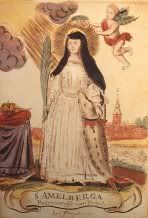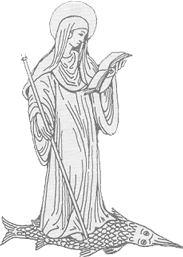Today, July 10, we celebrate the feasts of two saints with the same name—holy women who lived a century apart, but who are frequently confused. The details of the lives of Saint Amalburga of Temse and Saint Amalburga of Maubeuge have been mostly lost to history, but the sanctity, miracles, and good works of these saints live on in holy legend.
Saint Amalburga of Temse (also known as Saint Amelia) is a Belgian saint who lived in the eighth century. She was likely a romantic acquaintance of Charlemagne, who fell in love with her grace and beauty and pursued her for seven years. During that time, she continuously refused to marry him, due to her desire and calling to enter a religious life. On one occasion during which he attempted to persuade her physically to marry him, Saint Amalburga threw herself at the foot of the church alter, where she was unable to be moved from by divine and miraculous intervention. Charlemagne tried so strenuously to pull her from her position that he broke her arm, later miraculously cured. Soon thereafter, he fell ill, and only after repenting and giving up his pursuit of Amalburga was he cured of his illness.
Additional miracles attributed to Saint Amalburga include communion with fish, especially a giant sturgeon on which she is reputed to have once crossed the Escant River. In memory of this event, local fishermen continue to offer sturgeon in the chapel of Saint Amalburga on her feast day each year. It is said that no sturgeon are even seen in the waters of the Escant, except on July 10, when one always presents itself. Similarly, sturgeon were reported to have been observed escorting her funeral barge up the river, following her death. And while she lived, Amalburga is said to have fed the masses during famine with the flesh of large fish which appeared opportunely in the river.
Saint Amalburga is also said to have created miraculous springs in the fields, during time of drought, and healed many sick. A small chapel remains in her name, where miraculous cures have been reported. Her relics have resided in Saint Peter's abbey church in Ghent, Belgium since 1073. Saint Amalburga of Temse is the patron of farmers, fishermen, young people struggling to stay faithful to Christ, and those with fevers, bruises and arm pain.
Saint Amalburga of Maubeuge was a Lotharingian (short-lived Western European kingdom, where the modern-day Netherlands now stand) saint who lived in the seventh century. She was born of royalty, and unlike the virginal Amalburga of Temse, married the Duke of Lotharingia. Together, the two holy parents produced four children, each of whom, under her instruction, were later canonized saints for their piety, holy works, and faith.
As she aged, Amalburga felt called more and more to religious life of a nun, and her husband to that of a monk. They eventually parted ways, both joining separate religious orders. Amalburga entered the monastic community at Maubeuge Abbey—a Benedictine cloister. There, she lived out her life in prayer, contemplation, and silence, committing herself to the Lord. Her relics are housed in the Belgian city of Binche.
At first glance, the lives of these two holy women are quite different. Yet we celebrate their feast days on the same day of the year, and in doing so find the similarities between them. Saint Amalburga of Temse wrought miracles for the poor, and committed herself wholeheartedly to the Lord. Saint Amalburga of Maubeuge raised a devout and pious family, and also listened intently to the will of the Lord, committing herself to Him. One life appears flashy and filled with miracles, whereas the other seems quiet and contemplative, filled with the daily activities of a wife and mother. And yet, both women are remembered for their holiness and contributions to the Church. We are reminded that each of our lives are special and beautiful to the Lord—that we are called to play roles in the lives of others and the life of the Church based upon the special talents and gifts that have been bestowed upon us. Just as Saint Amalburga of Temse could not have filled the role of Saint Amalburga of Maubeuge, nor should we live a life other than that desired for us by the Lord. When we listen for His Will, we can accomplish miraculous things!
Year 2: Day 191 of 365
Prayer Intentions: Comfort in our suffering; Union with Christ.
Requested Intentions: For a daughter’s successful examination results (A); Occupational success, health and safety of family (S); Reduction in anxiety for husband, financial freedom (S); Healing for a sister-in-law (J); For a family experiencing a difficult child custody case (M); Reunification of a family struggling with separation (M): For a son struggling with mental illness (M); Successful examination results (B); To be freed from the chains of sin (J); Admission to a good university (M); For successful surgery (T); For a mother’s mental health and for kindness and forgiveness, for housing problems, for dental health (T); For the soul of a departed friend (X); Restoration of health (D); Successful employment for couple (N); For employment for children (K); For health of friend, for successful relationships for children, for safe pregnancy for daughter (C); For the health of a mother (J); Virtue for daughter (V); Successful acceptance to college for nephew (M); For the health of a cousin (T); Freedom from legal difficulties for husband (S); Husband’s freedom from illness (L).
Why pray the Rosary every day for a year?
Each time the Blessed Virgin has appeared-- whether it be to Saint Bernadette Soubirous at Lourdes; to Lucia, Jacinta, and Francisco at Fatima; or to Mariette Beco at Banneux-- she has asserted the importance, saving grace, and power of praying the Holy Rosary on a daily basis. Based upon her words, the Rosary is penance and conversion for sinners, a pathway to peace, an end to war, and a powerful act of faith in Jesus Christ. Pope Paul VI presented the Rosary as a powerful means to reach Christ "not merely with Mary but indeed, insofar as this is possible to us, in the same way as Mary, who is certainly the one who thought about Him more than anyone else has ever done."
To show us how this is done, perhaps no one has been more eloquent than the great Cardinal Newman, who wrote: "The great power of the Rosary consists in the fact that it translates the Creed into Prayer. Of course, the Creed is already in a certain sense a prayer and a great act of homage towards God, but the Rosary brings us to meditate again on the great truth of His life and death, and brings this truth close to our hearts. Even Christians, although they know God, usually fear rather than love Him. The strength of the Rosary lies in the particular manner in which it considers these mysteries, since all our thinking about Christ is intertwined with the thought of His Mother, in the relations between Mother and Son; the Holy Family is presented to us, the home in which God lived His infinite love."
As Mary said at Fatima, "Jesus wants to use you to make Me known and loved. He wishes to establish the devotion to My Immaculate Heart throughout the world. I promise salvation to whoever embraces it; these souls will be dear to God, like flowers put by Me to adorn his throne."

Subscribe to:
Post Comments (Atom)










0 comments:
Post a Comment
Thanks for leaving a comment. If you wish to submit a prayer request, however, please do so above, using the "Contact" tab.